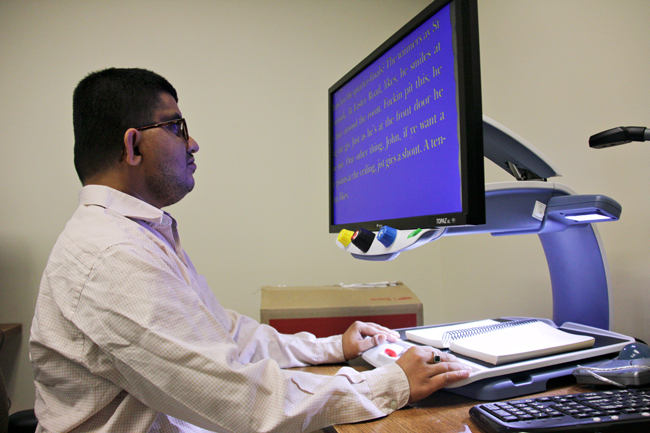When Jennifer Applegate purchases her books for the coming semester, she brings the texts to the Student Services Building, where they are stripped from their binding and fed into a scanner. Applegate doesn’t hate books — she is legally blind, and this process enables her to access her assignments through screen-reading software.
Applegate, an English senior, is one of 42 students with visual impairments registered with Services for Students with Disabilities, according to disabilities services coordinator Emily Shryock. Other students might be visually impaired, but they choose to work individually with professors and not use the accommodations the University provides.
“The only way we can track the numbers is if [students] choose to self-disclose their disability and register with our office,” Shryock said. “Some students are able to work individually with professors and may not need to use the accommodations or support offered by our office.”
Craig High, the coordinator of assistive technology in the Services for Students with Disabilities office, said he feels the office is successful because it responds to the demands of students.
“We’re 100 percent consumer-driven,” High said. “I’m here to support the students, so I try to mirror whatever strategies they’re already using.”
High said oftentimes, by the time a blind student enters college, the student has already determined successful study methods.
“When we see students, they’re already pretty much an expert, and they already know what works for them,” High said. “My job is to keep my pulse on what students are using at home and try to get those technologies in place here.”
Applegate said she feels the University is generally committed to increasing accessibility for blind students.
“Textbooks from the Co-op get back to me really quickly, although PDF documents can be really slow,” Applegate said. “But in general, the University is really good about being inclusive and diverse — whenever there are stairs, there will also be a ramp.”
Still, Applegate said, there are ways in which the University does not accommodate blind students. She cited Waggener Hall, which does not have signs posted in braille. Earlier this year, Applegate mistakenly entered a men’s restroom in the building as a result.
“I didn’t realize what had happened until I heard men’s voices, and I tried to leave as fast as I could,” Applegate said. “That wasn’t fun.”
Applegate said she contacted Student Services about the incident, but has not had time to follow up on getting braille installed.
“I’ve been swamped with schoolwork, and I know it’s an old building, so [the administration] probably thought it wasn’t a big deal,” Applegate said. “I know it’s a big project.”





















